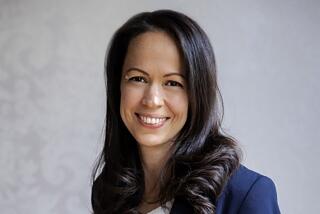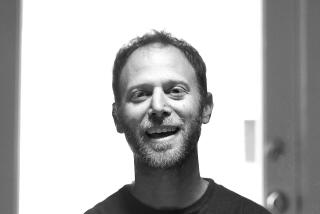Charles Rosen, 85; Pioneer in Artificial-Intelligence Research
- Share via
Charles Rosen, whose pioneering work in artificial intelligence led to the invention of “Shakey,” the first mobile robot that could reason about its actions, died of pneumonia Dec. 8 at his home in Atherton, Calif. He was 85.
Rosen, an electrical engineer whose wide-ranging interests included agriculture and the chemistry of foods, was a co-founder of Ridge Vineyards, a California winery credited with a major role in the revival of zinfandels.
His most memorable work in robotics took place at Stanford Research Institute, now known as SRI International, a nonprofit research and development company in Menlo Park, Calif.
As the first director of SRI’s Artificial Intelligence Center, he oversaw the development in 1966 of Shakey, a robot equipped with a television camera, range finder, bump detectors, and a clever reasoning program that enabled it to plan and execute simple tasks such as moving a box around a room.
“It was the first robot that had the ability to make plans and perceive its environment,” said Nils Nilsson, emeritus professor of computer science at Stanford University, who was Rosen’s project manager on Shakey.
Although conceived as a pure research project, Shakey incorporated technologies that bred many practical applications still in use, from driver navigation software used in Internet services such as Mapquest to “machine vision” systems that enable a robot to inspect and move a part on a factory assembly line.
The Shakey project also benefited the U.S. space program, providing the basis for much of the software that ran the Mars Rover developed by the Jet Propulsion Laboratory.
“Charlie did not write the papers, but he was the visionary who started all this. He assembled the team of creative people who together invented this stuff,” said Peter Hart, a protege of Rosen’s who is chairman and president of Ricoh Innovations Inc., a subdivision of the Japanese electronics firm that focuses on artificial intelligence and neural networks.
Rosen was raised by his mother in what he often described as the “red light district” of Montreal, Canada. Although his family was poor, he read every book and magazine he could find about electronics. He set up a laboratory above the candy store his mother operated and with a friend used tin foil, pencil lead and scrap parts to build crystal radios.
Unable to afford college, he moved to the United States and worked as a waiter in the Catskills. While waiting on tables, he met a professor who told him about Cooper Union College, the private, tuition-free school in New York City founded by a workingman’s wealthy son.
Rosen earned a degree in electrical engineering at Cooper Union. He later received a master’s from McGill University in Montreal and a doctorate from Syracuse University.
During World War II, he returned to Canada to test planes for the Royal Canadian Air Force. After the war, he was hired by General Electric in Schenectady, N.Y., to manage a group working on transistor devices. He co-authored an early textbook on transistors.
During a trip west, he fell in love with California and moved his family there when he found work at the Stanford Research Institute, which was established in 1946 by a group of West Coast industrialists in conjunction with Stanford University.
Rosen guided the institute’s Artificial Intelligence Center to its rank as one of the world’s foremost AI laboratories. He was known for his renaissance appetite for knowledge in diverse fields, from physics and neurobiology to many branches of engineering -- a wide-ranging intelligence that colleagues said fueled his creativity.
He was not above playing the role of gremlin, donning an opera cape and scampering about the room moving the objects Shakey was to find in an attempt to foil the robot’s exercises.
He also was the type of person who could, with utmost confidence, pose a seemingly unanswerable question, such as: If every person in Los Angeles screamed at the top of his lungs for exactly one second, would the total amount of energy emitted be enough to boil water for a cup of tea?
“You wouldn’t have any idea what the answer was,” Hart recalled, “but Charlie, off the top of his head, could give you a ballpark figure.
“You can only invent with what’s in your head. He had a head crammed full of facts and figures from so many disciplines.”
In 1959, Rosen and three scientists from the Stanford group bought investment property in the Santa Cruz Mountains. The land had old grapevines, attractive to Rosen, who had made wine in his garage.
Tending the vineyard became a weekend hobby for the scientists and their families. It became more than a hobby after “people began tasting the wine and saying, ‘My god, this is fantastic,’ ” said his son, Hal. The hobbyists began producing wine for sale in 1962.
Today, the winery is known for its zinfandels and Cabernets, “most of which are at the top of their class,” according to Wine Spectator senior editor James Laube’s guide “California Wine.”
Rosen and his partners sold the winery in the 1980s to a Japanese pharmaceutical conglomerate. But he continued to invent products and businesses into his 80s.
In 1980, after leaving SRI, he co-founded Machine Intelligence Corp., which specialized in making machines that could recognize industrial parts as they moved along a conveyor belt.
He also started a company that sold a mix for making pickles at home. Two years ago, at age 83, he invented a device to dispense inhaled drugs, a product of his frustration with the inhaler he used to treat his emphysema. It was bought by another company and is in development.
Rosen’s wife of 61 years, Blanche, died in June. In addition to his son Hal, he is survived by another son, Steve of San Francisco; daughters Naomi of Sonoma, Calif., and Sema of San Mateo, Calif.; and five grandchildren.







